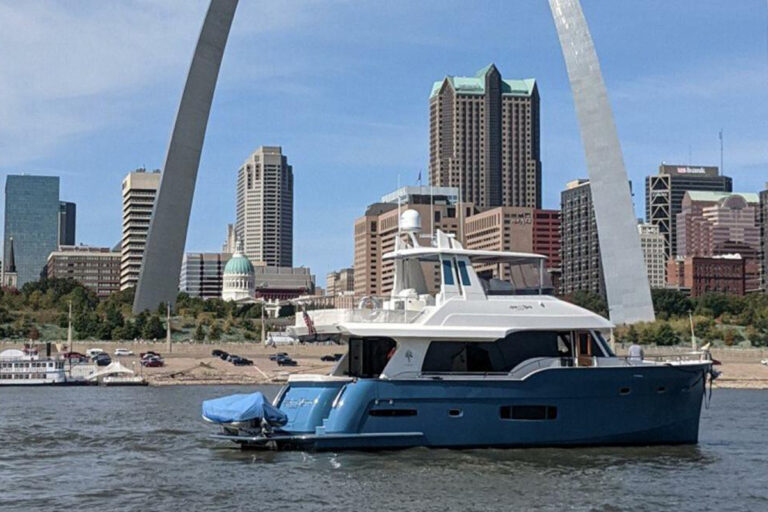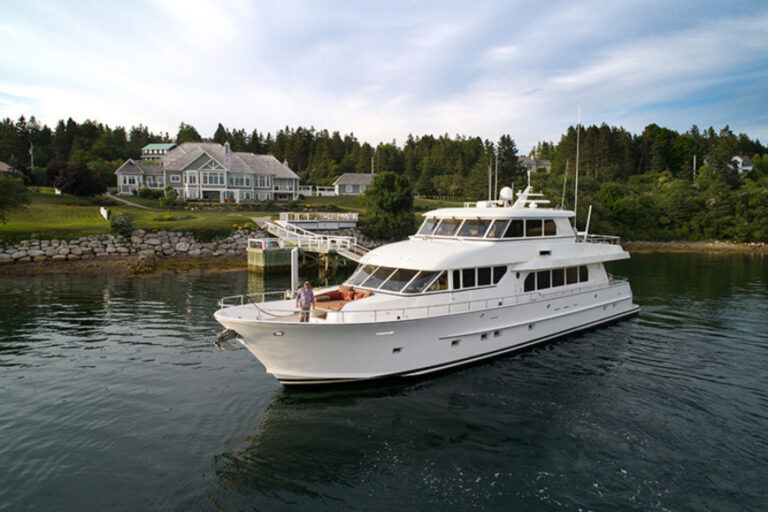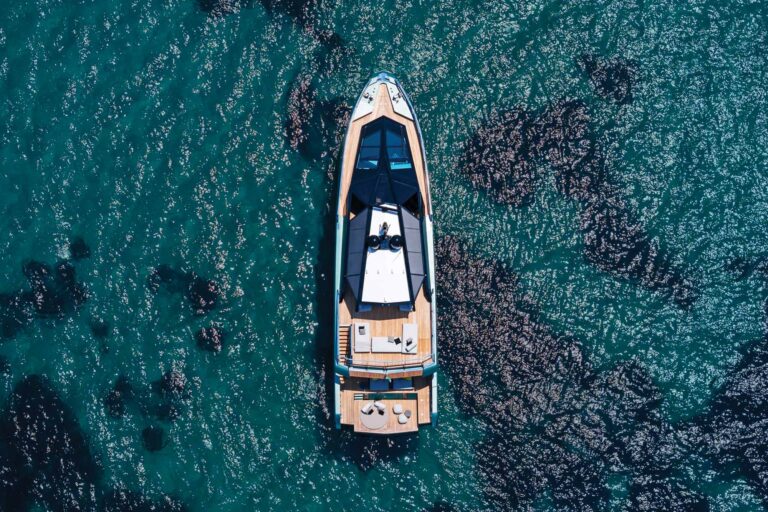The Huckins brand stirs emotions in those with a lifelong love of yachts. Established in Jacksonville, Florida, in 1928 by Frank Pembroke Huckins, the yard has enjoyed something of a renaissance in the capable hands of his granddaughter, Cindy Purcell. The new Ortega 44, Huckins’ 449th hull, is an example of the builder’s connection with the past and its vision of the future.
While it might be tempting to pigeonhole the Ortega as a retro design, those who know the yard’s history realize such a classification is misleading. It is true that she is reminiscent of earlier Huckins yachts, however, like her sistership, the Atlantic (introduced in 1998), her styling has been updated with a somewhat-softer brush, and her interior is designed to satisfy the expectations of modern yachtsmen. Beneath her distinct lines, her construction and systems specifications illustrate the wisdom gained in 75 years of yacht building.
“Granddad was always looking forward, always inventing”, Purcell said, referring to Huckins’ patents in areas as diverse as lamination processes and gearbox designs. “He would be very disappointed in me if I did not do the same.”
The original Ortega, a 40-foot sedan, was introduced in the 1950s. Later, the yard offered a flying bridge model. A dozen or so were built, and owners used them for cruising and, occasionally, fishing. Interior accommodations were simple and included a settee, small galley, head and forward V-berth. Purcell knew a new design would have to include more accommodation space, so the yard added 4 feet in length overall.
Huckins’ literature for the new model shows a single-stateroom arrangement with the galley down, as well as hull number one’s two-stateroom arrangement with the galley up. In both, the forward stateroom has an island queen berth, a break from tradition. The galley is equipped with a refrigerator, microwave/convection oven, stainless-steel sink and an electric cook top. A settee has internal stowage, and a custom cherry Hi-Lo table is crafted at the yard. The lower helm station has space for instrumentation and several large electronic displays. There is also a small desk/navigation center, and the cabinetwork provides plenty of handy spots to stash cruising gear. Though hull number one’s interior was finished in cherry, the joinery design and layout are flexible.
The added LOA also resulted in more exterior deck space. Engine boxes in the teak-soled cockpit are fitted with cushions, and there is room aft for several captains’ chairs and a table. The bridge has a helm seat, full controls, a small area for electronics and a bench seat. A built-in refrigerator is positioned strategically within reach of the skipper.
Frank Huckins pioneered cold-molded construction in the 1940s using resorcinol glue and mahogany, a process he employed successfully in the construction of a prototype for the PT boats that served in World War II. By the 1970s, the yard had shifted its focus and was working on the development of fiberglass hulls that could compete with lighter, cold-molded wood hulls. Solid fiberglass structures were relatively heavy, so the yard helped develop a one-off, sandwich construction method using fiberglass skins to encapsulate a closed-cell foam core. This increased the stiffness of the bottom without increasing weight. Today, this form of composite construction is quite common.
The Ortega’s construction is a refinement of this process. Instead of one-off construction over a disposable male plug, her hull is built in reusable female tooling with stitched E-glass reinforcement over Core-Cell foam. Fiberglass stringers are built over foam and supported by foam-cored fiberglass bulkheads. The same hull tooling used to build the Ortega is used for the Atlantic model. Superstructures are built in a similar fashion and are mechanically fastened and fiberglassed to the hull. Exterior surfaces are finished with Awlgrip. Purcell said the Ortega is 10 percent lighter than she might have been had she been built with traditional cold-molded construction methods.
The Ortega’s hull form derives from the original lines laid down by Purcell’s grandfather.
“Granddad helped change the way people thought about going fast at sea”, said Purcell. “He understood that for high speed, boats that went over the waves (planed) were more efficient than those that went through them.” Huckins coined the term “Quadraconic” to describe the planing hull form he created, as it was “developed using four conical projections.
The formula has evolved over the years, but the principle remains the same. Full-length hard chines define a fine entry forward that transition to an efficient planing surface aft with just 2 degrees of deadrise at the transom. The Ortega’s beam of 13 feet, 9 inches is relatively svelte and helps drive her with less power than you might expect. This is as much an asset today with diesel power as it was when big-block gasoline engines ruled.
Huckins is open-minded in terms of powering, and the Quadraconic hull has proven itself at speeds far greater than 40 knots. Hull number one was equipped with a pair of 370 hp Cummins. I recorded a top speed of 30.4 knots and a cruising speed of 24.6 knots at 2400 rpm. While some may entertain the thought of going faster, this seems the ideal speed for a boat of this size and service.
Water breaks cleanly from her transom at just 9 knots and from her chines at a bit more than 13 knots. Swing her wheel over hard and she cuts tightly, banking only slightly inboard-far less than is common on deeper deadrise designs. Trim tabs are unnecessary, since she runs at about 31/2 degrees at speed. Her attitude remains consistent regardless of loading, as the center of gravity of her major consumable (fuel) is positioned at or very near her center of buoyancy.
With the experience of having run hundreds of different boats over the years, I can tell you that no boat handles and feels like a Huckins. In my mind’s eye, I can see myself at the helm of a PT boat charging through the seas at high speed. Obviously, Purcell agrees. She is the proud owner of a 1951 Ortega, the boat that inspired her to rethink and rework the design. She has logged quite a few hours on the new Ortega, as well.
“Granddad believed the best way to promote your product was to cruise aboard it. He let the boat sell herself”, said Purcell.
Over the years, Huckins has been called on to build everything from modern tournament sportfishermen to flush-deck motoryachts. Still, the yard’s classically inspired designs move me the most. In an environment with production boats of every conceivable stripe, the Ortega 44 stands out. Everything about her, from the no-nonsense cut of her profile to her custom cast hardware, is distinctly Huckins. While this will please the passionate, Purcell has achieved her own goal: a design that makes sense. She would be a wonderful choice for poking about the coast of Maine or wandering the Bahamas.
Contact: Huckins Yacht Corp., (904) 389-1125; www.huckinsyacht.com.









